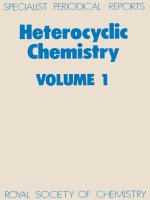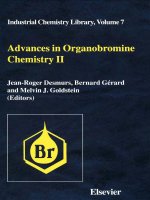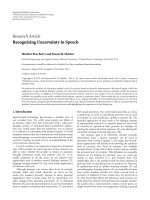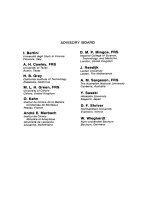Advances in heterocyclic chemistry, volume 101
Bạn đang xem bản rút gọn của tài liệu. Xem và tải ngay bản đầy đủ của tài liệu tại đây (9.63 MB, 244 trang )
EDITORIAL ADVISORY BOARD
A. T. Balaban, Galveston, Texas
A. J. Boulton, Norwich, England
D. Comins, North Caroline, United States of America
J. Joule, Manchester, United Kingdom
V. Minkin, Rostov-on-Don, Russia
A. Padwa, Georgia, United States of America
C. A. Ramsden, Keele, England
E. F. V. Scriven, Trafalgar, Indiana
V. Snieckus, Ontario, Canada
B. Stanovnik, Ljubljana, Slovenia
C. Stevens, Gent, Belgium
R. Taylor, York, United Kingdom
J. A. Zoltewicz, Gainesville, Florida
Advances in
HETEROCYCLIC CHEMISTRY
VOLUME
101
Editor
ALAN R. KATRITZKY, FRS
Kenan Professor of Chemistry
Department of Chemistry
University of Florida
Gainesville, Florida
Amsterdam • Boston • Heidelberg • London • New York • Oxford
Paris • San Diego • San Francisco • Singapore • Sydney • Tokyo
Academic Press is an imprint of Elsevier
www.pdfgrip.com
Academic Press is an imprint of Elsevier
Linacre House, Jordan Hill, Oxford OX2 8DP, UK
84 Theobald’s Road, London WC1X 8RR, UK
Radarweg 29, PO Box 211, 1000 AE Amsterdam, The Netherlands
30 Corporate Drive, Suite 400, Burlington, MA 01803, USA
525 B Street, Suite 1900, San Diego, CA 92101-4495, USA
First edition 2010
Copyright � 2010 Elsevier Inc. All rights reserved
No part of this publication may be reproduced, stored in a retrieval system
or transmitted in any form or by any means electronic, mechanical, photocopying,
recording or otherwise without the prior written permission of the publisher.
Permissions may be sought directly from Elsevier’s Science & Technology Rights
Department in Oxford, UK: phone (+44) (0) 1865 843830; fax (+44) (0) 1865 853333;
email: Alternatively you can submit your request online by
visiting the Elsevier web site at and selecting
Obtaining permission to use Elsevier material.
Notice
No responsibility is assumed by the publisher for any injury and/or damage to persons
or property as a matter of products liability, negligence or otherwise, or from any use
or operation of any methods, products, instructions or ideas contained in the material
herein. Because of rapid advances in the medical sciences, in particular, independent
verification of diagnoses and drug dosages should be made
ISBN: 978-0-12-381306-0
ISSN: 0065-2725
For information on all Academic Press publications
visit our website at www.elsevierdirect.com
Printed and bound in USA
10 11 12 13 14 10 9 8 7 6 5 4 3 2 1
Working together to grow
libraries in developing countries
www.elsevier.com | www.bookaid.org | www.sabre.org
www.pdfgrip.com
CONTRIBUTORS
Numbers in parentheses indicate the pages on which the author’s
contribution begins.
David StC Black (97)
School of Chemistry, The University of New South Wales, UNSW
Sydney, NSW 2032, Australia
El Sayed H. El Ashry (161)
Chemistry Department, Faculty of Science, Alexandria University, Alex
andria, Egypt; Fachbereich Chemie, Universitate Konstanz, D-78457 Kon
stanz, Germany; and International Center for Chemical and Biological
Sciences, HEJ Research Institute of Chemistry, University of Karachi,
Karachi 75270, Pakistan
Yeldez El Kilany (161)
Chemistry Department, Faculty of Applied Sciences, Um-Alqura Univer
sity, Makka, Saudi Arabia
Raymond C.F. Jones (125)
Department of Chemistry, Loughborough University, Loughborough,
Leicestershire LE11 3TU, UK
Rahul D. Kavthe (75)
Organic Chemistry Division II, Indian Institute of Chemical Technology,
Hyderabad 500 607, India
Naresh Kumar (97)
School of Chemistry, The University of New South Wales, UNSW
Sydney, NSW 2032, Australia
Charles N. Moorefield (1)
Maurice Morton Institute for Polymer Science, The University of Akron,
Akron, OH 44325, USA
vii
www.pdfgrip.com
viii
Contributors
Said Nadeem (161)
International Center for Chemical and Biological Sciences, HEJ Research
Institute of Chemistry, University of Karachi, Karachi 75270, Pakistan
George R. Newkome (1)
Departments of Polymer Science and Chemistry, The University of
Akron, Akron, OH 44325-4717, USA and Maurice Morton Institute for
Polymer Science, The University of Akron, Akron, OH 44325, USA
Nitin T. Patil (75)
Organic Chemistry Division II, Indian Institute of Chemical Technology,
Hyderabad 500 607, India
Muhammad Raza Shah (161)
International Center for Chemical and Biological Sciences, HEJ Research
Institute of Chemistry, University of Karachi, Karachi 75270, Pakistan
Monica Soler (1)
Departments of Polymer Science and Chemistry, The University of
Akron, Akron, OH 44325-4717, USA
Yoshinori Yamamoto (75)
WPI-AIMR (Advanced Institute for Materials Research), Tohoku Univer
sity, Katahira 2-1-1, Aobaku, Sendai 980-8577, Japan and Department of
Chemistry, Graduate School of Science, Tohoku University, Aramaki,
Aobaku, Sendai 980-8578, Japan
www.pdfgrip.com
MILESTONE OF 100 VOLUMES OF
ADVANCES IN HETEROCYCLIC
CHEMISTRY MARKED BY THE
PUBLICATION OF VOLUMES 99, 100,
AND 101 AS A CELEBRATORY SET
It is hard to believe that it is now 50 years since I conceived the concept of
periodical volumes of these “Advances” that would record progress in
Heterocyclic Chemistry. In 1960, heterocyclic chemistry was slowly emer
ging from the dark ages; chemists still depicted purines by the archaic
structural designation introduced (was it by Emil Fischer?) 50 years
before that. Together with Jeanne Lagowski I had published in 1959 a
modern text on heterocyclic chemistry, the first that treated this subject in
terms of structure and mechanism and attempted to logically cover sig
nificant methods of preparation and reactions of heterocyclic compounds
as a whole, all in terms of reactivity.
The first two volumes of Advances contained extensive chapters on
the tautomerism of various classes of heterocycles. Despite the great
influence the precise structure of heterocyclic compounds has on chemi
cal and biological properties (we only have to remember base pairing of
nucleotides to illustrate this), at that time the literature was replete with
incorrectly depicted tautomers. The basis for the position of tautomeric
equilibria was usually completely misunderstood. Although great pro
gress has been made in the last 50 years, there still exist holdouts even
among otherwise reputable chemists who persist in depicting 2-pyridone
as ‘‘2-hydroxypyridine’’ which is a very minor component of the tauto
meric equilibrium under almost all conditions.
Over the years Advances in Heterocyclic Chemistry has indeed mon
itored many of the advances in the subject: the series is now boosted by
“Comprehensive Heterocyclic Chemistry” of which the first edition was
published in 1984 in 8 volumes, followed by the second edition in 1996 in
11 volumes and the third in 2008 in 15 volumes. Heterocyclic chemistry
ix
www.pdfgrip.com
x
Milestone of 100 Volumes of Advances in Heterocyclic Chemistry
has now taken its place as one of the major branches (by several criteria
the most important) of Organic Chemistry.
Chemistry has rapidly become the universal language of molecular
interactions; it has essentially taken over biochemistry and is rapidly
gaining dominance in zoology, botany, physiology and indeed in many
branches of medicine.
Chemical structural formulae are quite basic to this progress and have
enabled us to rationalize many natural phenomenon and countless
reactions both simple and exotic discovered in the laboratory.
Now we have reached the milestone of 100 volumes of the series. In
place of a single volume we are offering the three volume set 99, 100 and
101 which contain a fascinating variety of reviews covering exciting
topics in heterocyclic chemistry.
Alan R. Katritzky
Gainesville, Florida
www.pdfgrip.com
PREFACE TO VOLUME 101
The final volume celebrating the attainment of the century for AHC
contains five chapters contributed by heterocyclic chemists from six
countries.
Soler, Moorefield, and Newkome (U. Akron, Akron, OH, USA) start
with a fascinating account of the Senior Author’s work on the construc
tion of hexameric macromolecular architectures in organic chemistry.
Patil, Kavthe, and Yamamoto (I.I.C.T., Hyderabad, India, and Tohoku
U., Japan) summarize metal catalyzed cyclizations of alkynes bearing a
heteroatom attached to a substituent which migrates during the
annulation.
The chemistry of the 28 possible isomeric biindolyl structures is cov
ered by Black and Kumar (UNSW, Sydney, Australia), while R.C.F. Jones
(Loughborough U., Loughborough, UK) has reviewed his own and
others’ research on annulation reactions of 2-imidazoline. The volume
closes with an upto date account of the chemistry of the Dimroth Rear
rangement contributed by E.S.H. El Ashry, S. Nadeem, M.R. Shah, and
Y.E. Kilany of Alexandria U. in Egypt.
Alan R. Katritzky
Gainesville, Florida
xi
www.pdfgrip.com
CHAPTER
1
Hexameric Macrocyclic
Architectures in Heterocyclic
Chemistry
Monica Soler,a Charles N. Moorefieldb and
George R. Newkomea,b
Contents
1. Introduction
2. Macrocycles with Five-Membered Heterocyclic Subunits
2.1 Furan, tetrahydrofuran, and thiophene
2.2 Pyrrole
2.3 Cucurbituril
2.4 Cyclofructans
2.5 Diazole
3. Six-Membered Ring Heterocycles
3.1 Pyridine
3.2 Pyrimidine
3.3 Phenanthroline
3.4 Oligosaccharides
4. Miscellaneous Heterocyclic Materials
4.1 Flexible rings
4.2 Terpyridine and phenanthroline
4.3 Five- and six-membered
4.4 Nucleobases, nucleosides, and nucleotides
5. Conclusions
References
2
3
3
6
18
19
21
22
22
53
54
56
58
58
59
60
64
66
66
a
Departments of Polymer Science and Chemistry, The University of Akron, Akron, OH 44325-4717, USA
b
Maurice Morton Institute for Polymer Science, The University of Akron, Akron, OH 44325, USA
Advances in Heterocyclic Chemistry, Volume 101
ISSN 0065-2725, DOI 10.1016/S0065-2725(10)01001-9
Ó 2010 Elsevier Inc.
All rights reserved
1
www.pdfgrip.com
2
Monica Soler et al.
1. INTRODUCTION
Peter Stang once noted (97JA4777) that “In nature the hexagon represents
the most common pattern throughout biological morphology from the
simple diatoms to the bee honeycomb” after reading a treatise by Geof
frey Ozin (97ACR17) describing his investigations into the morphosynth
esis of hierarchical inorganic structures, such as that of the radiolaria. The
ubiquitous occurrence of the hexagonal motif in nature coupled with
Peter Pearce’s postulate (78MI1) that “structure in nature is a strategy
for design” provides insight and reason to the plethora of diverse hex
agonal architectures formed throughout synthetic chemistry. As well, the
burgeoning arena of Supramolecular Chemistry, pioneered by Jean-Marie
Lehn (78PAC871, 88AGE89, 95MI1), expands the platform for access to
self-assembled macrocycles based on the attractive interactions between
select metal ions and structurally compatible heterocyclic ligands. Trans
cending consideration of covalent versus non-covalent bonding, supra
molecular chemistry considers building blocks instilled with angles,
coordination sites, and affinities that drive their assembly to architectures
with utilities and designs not accessed from the starting materials alone.
Conjointment of the supramolecular regime with directed and conver
gent synthetic protocols has facilitated new routes to macrocyclic
structures.
In a seminal review of the field of self-assembly of architectures
mediated by transition metals Stang et al. (00CRV853) discussed and
delineated design strategies or models developed over the years by
such notable scientists as Saalfrank (97AGE2482), Lehn (99CEJ102,
99CEJ113), Raymond (99ACR975) [“Symmetry Interaction” Model], Ver
kade (83JA2494), Fujita (98CSR417), and Stang (97ACR502, 98JCD1707)
[“Molecular Library Model”].
The Symmetry Interaction model considers the geometric relationships
between ligand coordination sites and metal centers by defining chelate
or coordinate vectors, based on the directional orientation of the ligandbinding sites. For example, a bidentate bipyridine ligand coordinated to a
metal possesses a vector pointing toward the metal that bisects the chelating
group. The Molecular Library model considers the directionality and
geometry of multibranched, monodentate ligands and their ramifications
on the geometry of the desired molecular architecture. For example, rod
like building blocks with incorporated angles of 90° and end-group
coordination sites would generate a tetragonal shape in the presence of
a connecting metal that is capable of sustaining 90° coordination.
Herein, we present a brief overview of the current literature dedicated
to hexameric macrocyclic architectures predicated on heterocyclic chem
istry. We summarize the salient synthetic features of ring construction
whereby the participating heterocyclic building blocks, or subunits,
www.pdfgrip.com
Hexameric Macrocyclic Architectures in Heterocyclic Chemistry
3
possessing at least one heteroatom, such as nitrogen, oxygen, or sulfur,
with the recognition that such a broad subject will necessitate a limitation
in scope.
Excluding the “Introduction,” this review is organized based on the
building blocks used for macrocycle construction into three sections: fivemembered heterocyclic subunits, such as furan, furanose, or pyrole;
six-membered heterocyclic subunits, such as pyridine, bipyridine, phenan
throline, or glucopyranose; and miscellaneous subunits comprising, for
example, a combination of five- and six-membered heterocyclic subunits
or larger than six-membered ring subunits. We have sought to include as
many pertinent new and classical examples as possible and will endeavor
to include examples that have been missed in future manuscripts.
2. MACROCYCLES WITH FIVE-MEMBERED HETEROCYCLIC
SUBUNITS
2.1 Furan, tetrahydrofuran, and thiophene
Hexameric macrocycles possessing subunits with oxygen have been
reported, of which some of the earliest examples incorporated a series
of 18-crown-6 ethers containing one-, two-, or three-furanyl subunits
(74JA7159). In 1955, Wright et al. reported (55JOC1147) the first example
of calix[6]furan 1, comprising six furan rings joined by sp3-hybridized
carbons. Such calix[6]furans possess a p-electron-rich cavity with a
hydrophilic character similar to crown ethers, but with decreased elec
tron-donating character compared with ethereal analogues (05AHC65).
The calix[6]furan 1, which contains methyl groups in the meso-positions,
was synthesized following a two-step procedure involving the formation
of a three-furan linear oligomer by an acid-catalyzed condensation of
furan and acetone. Once the linear trimer was isolated, cyclization was
achieved by reaction with acetone in the presence of hydrochloric acid
affording (9%) the heterocycle 1 along with linear oligomers (Scheme 1).
Kobuke et al. (76JA7414) modified the procedure for 1 by bubbling
hydrogen chloride gas into a solution of acetone and linear hexamer to
afford 1 in 52% yield. Other modified procedures include the addition of
concentrated HCl, acetone, and linear hexamer in ethanol containing Liỵ
or Csỵ ions or no metal, which afforded 1 in ~50% yields (85JCS(P1)973),
or slow addition of linear trimer and acetone to a diluted EtOH/HCl
mixture with 25% yield (96TL4593). Musau et al. reported (93CC1029,
94JCS(P1)2881) the synthesis of the calix[6]furan with unsubstituted
methylene bridges, by cyclization of the corresponding linear hexamer
using dimethoxymethane, in the presence of BF3ÁEt2O, as the catalyst;
however, the desired hexamer was isolated in ~1% yield. Kobuke et al.
www.pdfgrip.com
4
Monica Soler et al.
Scheme 1
(76JA7414) also reported the tetrahydrofuran analogue (Scheme 1) by the
hydrogenation of the furan units of 1 using ruthenium/carbon under
high pressure conditions to generate an isomeric mixture of the hexamer
2, which was shown to extract cesium, ammonium, and silver ions from
an aqueous to an organic phase. Finally, a larger hexameric macrocycle
containing six furan rings joined via acetylene bridges was also reported
(69AJC1951).
Three examples of hexameric macrocycles containing thiophene rings
have been reported. Meijere et al. described (95AGE781) the novel macrocycle 4, composed of six thiophene rings linked via spirocyclopropane
bridges. Reaction of polyalkyne 3 with Na2S under basic conditions
afforded within an hour 4, which was isolated by recrystallization in
chloroform in 59% yield (Scheme 2). The crystal structure (Figure 1)
showed a chair-like conformation, in which three sulfur atoms are
above and three below the plane of the macrocycle.
Scheme 2
www.pdfgrip.com
Hexameric Macrocyclic Architectures in Heterocyclic Chemistry
Figure 1
VCH).
5
X-ray crystal structure of 4 (95AGE781) (Reproduced by permission from Wiley-
Ishii et al. (97CL897, 98BCJ2695) synthesized a sulfur-bridged thio
phene macrocycle 5. Several different conditions were examined for the
preparation of 5 from different oligomers; the best results were obtained
(~10%) by heating dibromo oligo(thio-2,5-thienylene) containing six
thiophene rings with Na2S in NMP in the presence of Cs2CO3 (Scheme 3).
Conditions such as CuI-catalyzed or non-catalyzed reactions also gave
the desired product, albeit in slightly lower yields. Sulfur-bridged calix
arene-like molecules could function as hosts to soft and heavy metal ion
guests.
Another example of a cyclohexathiophene was reported by Kauff
mann et al. (75AGE713), composed of six thiophene subunits bound
together through the 2,20 - and 3,30 -positions. It was isolated as a by
product in 4% yield, not completely purified, from the reaction designed to
obtain cyclotetrathiophene.
Jones et al. (95AGE661) reported the synthesis of silicon-bridged
heterocycles containing furan or thiophene subunits. Furan and thio
phene were deprotonated at the 2- and 5-positions in hexane, to generate
Scheme 3
www.pdfgrip.com
6
Monica Soler et al.
Scheme 4
the organolithium intermediates, followed by slow addition of Me2SiCl2
to afford the cyclic hexamer 6 or 7 (Scheme 4), respectively, along with
their corresponding cyclic tetramers. Macrocycles comprising other ring
sizes were detected in trace amounts by mass spectrometry.
2.2 Pyrrole
Examples of hexameric macrocycles containing pyrrole rings reported in
the literature (01CCR57, 08ACR265) include hexaphyrins or expanded
porphyrins, calix[6]pyrroles, and cyclo[6]pyrroles.
Hexaphyrins are conjugated macrocycles composed of six pyrrole
rings linked via sp2 hybridized carbon atoms. The first example, meso
hexaphenylhexaphyrin (9), was prepared by Bruckner et al. (97CC1689)
employing 5,10-diphenyltripyrrane (8) (Scheme 5), which was isolated as
a by-product from a reaction designed to generate 5-phenyldipyrro
methane, by the condensation of pyrrole and benzaldehyde in the pre
sence of an acid (94T11427, 94TL2455, 94TL6823). A 3 ỵ 3-type
condensation of trimer 8 with benzaldehyde, gave after oxidation
and chromatography, the cyclic hexamer 5. A similar example,
Scheme 5
www.pdfgrip.com
Hexameric Macrocyclic Architectures in Heterocyclic Chemistry
7
Scheme 6
meso-hexa(pentafluorophenyl)hexaphyrins, was reported by Cavaleiro et al.
(99CC385) using a modification of the Rothemund synthesis (39JA2912).
Calix[6]pyrroles are nonconjugated macrocycles composed of six pyr
role rings linked via sp3 hybridized carbon atoms. A simple and efficient
route to calix[6]pyrrole (98AGE2475) involved an acid-catalyzed conden
sation of dipyrrolemethane with simple ketones that afforded polypyr
role 10 (Scheme 6). X-ray structure determination of 10 revealed that
pyrrole units adopted a 1,3,5-alternate conformation in contrast to the
more prevalent cone conformation found in calix[6]arenes.
Another example in this family was reported by Sessler et al.
(05JOC5982), whereby the dodecafluorocalix[6]pyrrole 11 was con
structed (20%) by the condensation of 3,4-difluoro-1H-pyrrole with acet
one in the presence of methanesulfonic acid and tetrabutylammonium
chloride (Scheme 7).
Calix[6]pyrroles have also been synthesized (00AGE1496) by the con
version of a calix[6]furan to form the dodecaketone 12 via a ring-opening
process, as described by Williams and Le Goff (81JOC4143). Subsequent
reduction of the olefinic bonds and reaction with ammonium acetate gave
13 in 42% yield (Scheme 8).
Scheme 7
www.pdfgrip.com
8
Monica Soler et al.
Scheme 8
Host-guest chemistry of calixpyrroles has become an important area
of research. Compared to calix[4]pyrroles, which exhibit remarkable
selectivity for binding fluoride (96JA5140), calix[6]pyrroles have been
shown (01CC13) to form strong complexes with iodine. Other halide
ions have shown (00CC1207) strong affinities to trihaloalkanes, such as
trifluoroethanol, and electron-deficient aromatic systems, such as nitro
benzene or p-nitrotoluene.
Finally, cyclo[6]pyrroles are conjugated pyrrole-based macrocycles
that contain no meso-carbon bridge. Sessler et al. reported (03JA6872)
the preparation of the cyclo[6]pyrrole 14 [HCl salt of [22]hexaphyrin
(0.0.0.0.0.0)] (15%) by coupling 3,30 ,4,40 -tetraalkylbipyrroles under bipha
sic oxidative conditions (Scheme 9); cyclo[7]pyrrole and cyclo[8]pyrrole
were also isolated. Two crystal structures of 14 were also reported, one
containing two TFA2À ions (Figure 2) and the other two chloride ions.
Later, the uranyl cationic complex of 14 was obtained by treatment
with UO2[N(SiMe3)2]2 in CH2Cl2 under an inert atmosphere (07IC5143).
Notably, during this insertion and oxidation process, the initial aromatic
ring containing 22 p-electrons was transformed to the 20 p-electron antiaromatic heterocycle.
Scheme 9
www.pdfgrip.com
Hexameric Macrocyclic Architectures in Heterocyclic Chemistry
9
Figure 2 X-ray crystal structure of H2142ỵ2TFA2, showing top and side views
(03JA6872) (Reproduced by permission from American Chemical Society).
2.2.1 Porphyrin
Based on their natural occurrence, physicochemical properties, potential
to coordinate numerous metals, and access from readily available starting
materials, porphyrins provide ideal building blocks for more complex
architectures. Numerous researchers have studied these fascinating mate
rials (09ACR1193, 09CCR2036, 09CSR422, 09CSR2716, 10CCR77).
Anderson and Sanders (89CC1714) have reported the preparation
of an hexameric porphyrin-trimer to accommodate organic guests.
This cyclic trimer 16a was synthesized starting from a bis-acetylenic
porphyrin, obtained by reaction of 3-ethynylbenzaldehyde with
3,30 -diethyl-4,40 -dimethyldipyrromethane, followed by oxidation of the
porphyrinogen intermediate with DDQ (81JOC4792, 95JCS(P1)2223).
A cyclic Glaser coupling of the bis-acetylenic porphyrin Zn adduct 15a
using excess copper(I) chloride in pyridine at 25°C with air afforded the
cyclic trimer 16a (47%), after removing Zn with a dilute acid, along with
the cyclic tetramer (20%), cyclic pentamer (traces), and insoluble cyclic
dimer (Scheme 10). Addition of 2,4,6-tris-4-pyridyl-s-triazine (17) to the
metallated 16a formed complex 18a, suggesting that 17 had a complemen
tary shape for the cavity of the host 16a. Approximately 1 year later, the
same group published (90AGE1400) a ligand-templated synthesis
(93ACR469) of the cyclic trimer (16b) using tripyridine 17, as a template
for directing the assembly, which gave, 16b in 55% yield (Scheme 10, dash
line). The dramatic template effect observed with 17 enhanced the forma
tion of the cyclic trimer 16b by inhibiting formation of the related dimer.
The crystal structure of the porphyrin-trimer Zn adduct of 16a with three
coordinated pyridines to the three Zn ions is presented in Figure 3. It
˚
revealed an open, flexible cavity with a mean Zn—Zn distance of ~16 A
www.pdfgrip.com
10
Monica Soler et al.
Scheme 10
(a)
(b)
Figure 3 (a) X-ray crystal structure of the porphyrin-trimer Zn adduct 16a with three
coordinated pyridine ligands (94AGE429) (Reproduced by permission from Wiley VCH)
and (b) drawing of the Zn adduct of the platinum-linked cyclic porphyrin-trimer 19.
www.pdfgrip.com
Hexameric Macrocyclic Architectures in Heterocyclic Chemistry
11
(94AGE429). Another example of a cyclic porphyrin-trimer designed by
Sanders et al. (92CC43), with the same topology as 16a but with a larger
˚ cavity, was presented by the platinum-linked cyclic porphyrin-trimer
18 A
19. Condensation of trans-[Pt(PEt3)2Cl2] and 15a with deoxygenated 10%
(v/v) diethylamine in toluene, using Hagihara coupling conditions
(78OMC319) with CuI as a catalyst, afforded 19 in 16% yield (drawing
Figure 3b), together with expected intermediates. Attempts to increase the
yield by templating with (Pyacac)3Al gave no significant improvement.
Sanders et al. (95JCS(P1)2275) further reported the preparation of a cyclic
porphyrin-trimer with an increased cavity size using octatetrayne bridges
instead of butadiyne bridges.
Sanders et al. also described (03CEJ5211) the formation of a hexameric
macrocycle containing three Sn(IV) porphyrins with axial carboxylate
ligands generated from the Sn(IV) dihydroxo derivatives, to study the
ligand-recognition properties of tin(IV) porphyrins. Tin ion insertion into
the cyclic trimer 16b was performed by refluxing anhydrous tin(II)
dichloride in pyridine for 2 h, followed by the quantitative hydrolysis
(passing the sample through a weak anion-exchange resin in a waterchloroform mixture) to afford, after recrystallization, trimetallated 20 in
28% yield (Scheme 11). Aliquots of carboxylic acids were then added to 20
in order to study the NMR properties of 21a and 21b. A more versatile
linear synthesis allowed access to unsymmetrical cyclic trimers with
different bridge lengths (ethyne and butadiyne links) (98NJC493) or
mixed-metal trimers (97IC6117, 00IC5912).
In 1999, two other cyclic porphyrin families were reported contain
ing six-porphyrin subunits resembling that of the light harvesting
supramolecular architectures in photosynthetic bacteria (95NAT517,
96ACR381). Dossauer et al. reported (99TL8347, 01JOC4973, 06JA3396)
the construction of the rigid hexameric macrocycle 25, containing six tetra
phenyl-porphyrin rings linked by six meta-diethynylphenyl corners, thus
forming an internal cavity of 4.6 nm of diameter. The step-by-step method
Scheme 11
www.pdfgrip.com
12
Monica Soler et al.
Scheme 12
developed by this work enabled the synthesis of these macrocycles with
different metallation “‘states’,” composed of a combination of Zn porphyrin
(PZn), Ni porphyrin (PNi), and/or free-base porphyrins (PFB). The syn
thetic procedure (Scheme 12) started with the reaction of the diiodopor
phyrin derivative 22 with 23, affording a monomeric porphyrin-building
block 24b, with two reactive positions, a protected ethynyl group and a
diethyltriazine-substituted phenyl, which could be activated selectively.
Employing an interactive divergent—convergent approach (94JA4227,
94AGE1360) to generate the linear precursor, the intramolecular cyclization
was effected by a high-dilution, Pd(0)-mediated reaction. The final ringclosure step was the least reproducible affording after chromatographic
purification, the product with variable yields (8—31%). Template synthesis
of 25 was also attempted (06JA3396), where the yield of the cyclization of the
linear precursor was improved to a reproducible yield (52—57%).
www.pdfgrip.com
Hexameric Macrocyclic Architectures in Heterocyclic Chemistry
13
At about the same time, Lindsey et al. (99JA8927) described the one
flask synthesis of a different family of cyclic hexamers, containing six
porphyrins bridged by diphenylethynes. They also synthesized macrocycles with different degrees-of-metallation: one example with six PZn’s,
and another with an alternating arrangement of three Zn or Mg porphyrins
(PZn, PMg) and three free-base porphyrins (PFB). Macrocycle 29 was constructed (Scheme 13) by a Pd-mediated coupling of a Zn-metallated bis(4
ethynylphenyl)porphyrin 26 with metal-free bis(3-iodophenyl)porphyrin
27 in the presence of a tripyridinyl template 28 affording 5.3% yield after
purification (Scheme 13). Treatment of 29 with zinc acetate afforded the all
metallated polyporphyrin 30 that was isolated in 94% yield.
Two years later, (01JOC7402) this family of hexameric architectures was
extended with the addition of two more examples, comprising five PZn
and one PFB as well as comprising alternating sequence of two PZn
and one PFB. Synthesis of these new additions did not follow the oneflask template-directed process, but was achieved by sequential Pd
mediated coupling reactions involving four tetraarylporphyrin-building
www.pdfgrip.com
14
Monica Soler et al.
Scheme 13
blocks bearing diethynyl, diiodo, bromo/iodo, or iodo/ethynyl groups.
The final ring-closure yielding the cyclic construct was performed by the
reaction of a porphyrin pentamer and a porphyrin monomer or by joining
two porphyrin trimers in the presence of a template. Linsey et al.
(03JOC8199) later expanded this family of shape-persistent materials, by
generating new derivatives bearing diverse pendant groups, such as thiol
moieties, that were used to form self-assembled monolayers (SAMs). Char
acterization by high-angle X-ray scattering of a host—guest complex with a
tripyridyl guest has been reported (04JA14054).
The structures of the light-harvesting complexes (LH) in photosyn
thetic purple bacteria had been determined by X-ray crystallography
studies, electron microscopies, and other analytical methods
(95NAT517, 96MI1, 96MI2, 98JMB833, 01B8783). In these complexes, the
bacteriochlorophylls (32 in LH1 and 16 in LH2) are arranged in macroring
structures, where the key functional unit is composed of bacteriochlor
ophyll-a dimers, which have been described as having a slipped-cofacial
juxtaposition, held together by intermolecular forces, specifically the
coordination of imidazolyl to the central Mg ion (03JA2372, 03OL4935,
05JOC2745). Kobuke et al. reported (03JA2372) the first example of a
hexameric macrocycle 32 composed of six 5,50 -m-phenylene-bridged imi
dazolylporphyrinatozinc(II) dimers (31), where coordination of the imida
zolyl of one dimer to the zinc of the neighboring one closes the
macrocycle. Synthesis of 31 started with the acid-catalyzed condensation
www.pdfgrip.com
Hexameric Macrocyclic Architectures in Heterocyclic Chemistry
15
of meso-(n-heptyl)dipyrromethane with two aldehydes (isophthalalde
hyde and 1-methyl-2-imidazolecarbaldehyde), followed by oxidation,
which gave a mixture of porphyrin products. Column chromatography
afforded 5,50 -m-phenylene-bridged gable-porphyrin with 15,150 -bis(imida
zolyl) groups (31) (85JA4192) (Scheme 14) and other products. Addition of
zinc acetate converted the free base 31 to polymeric assemblies, which
after a reorganization process by cleavage of the coordination bonds upon
dilution in more polar solvent (mixture of CHCl3/MeOH), followed by
evaporation, afforded a mixture of two components, showing the disap
pearance of almost all the oligomers. Once these two products were
separated, analysis of the first one by small-angle X-ray scattering
(SAXS) measurement concluded that it was the hexameric macrocycle 32.
To further increase the stability, the macrocycle was covalently bound
by an olefin metathesis of the allyloxypropyl substituents (the pendant
groups in the meso-position of the porphyrin rings) in each dimer
(03OL4935) (Scheme 15). This reaction was used to connect each pair of
complementary coordinated porphyrins to the other pair. These macrocycles were analyzed by MALDI-TOF MS identifying the hexamer, along
with a pentamer.
Previous macrocycles containing gable-porphyrins (32–34) showed no
p-conjugation between porphyrins since the porphyrin and phenylene
planes were orthogonal. In an effort to introduce or increase conjugation,
Scheme 14
www.pdfgrip.com
16
Monica Soler et al.
Scheme 15
Kobuke et al. (06JA4612) also reported the synthesis of macrocycles using
bis(zinc-imidazolylporphyrin) linked by a m-bis(ethynyl)phenylene
spacer, allowing enhanced rotation along the ethyne axis.
A different structure was formed when the repeat unit in the macrocycle
was a trimer of porphyrin units instead of a dimer as seen with the gable
porphyrins. Kobuke et al. reported (04JA8668) the hexameric macrocycle
36, which consisted of three porphyrin-trimer units, containing only nine
porphyrin rings instead of twelve as in the precious macrocycles
(Scheme 16). The free-base porphyrin-trimer 35 was synthesized by con
densation of 5-(1-methylimidazol-2-yl)-10,15-bis(3-allyloxypropyl)-20-(3
formylphenyl)porphyrin with meso-methoxycarbonyldipyrromethane in
20% yield. Metallation by addition of Zn(OAc)2 and reorganization using
MeOH/CHCl3 mixtures afforded the cyclic hexamer 36. The two terminal
porphyrins of each trimer in the hexamer helped in ring formation by
coordination to the Zn ions of the terminal imidazole of the other trimer,
leaving three noncoordinated porphyrinato-Zn(II) sites that could accom
modate a functional molecule. 1H NMR spectra of 36 revealed a mixture of
two topological isomers, D3h-symmetric (36a) and D3h-asymmetric (36b).
Anderson et al. reported (08AGE4993) an efficient synthesis of
strained, p-conjugated D6h porphyrin[6]nanoring 39. A template-directed
reaction between the porphyrin dimer 37 and the hexapyridinyl template
38 by an oxidative coupling of 37 under palladium/copper catalysis,
using iodine and air, as the oxidants, afforded the cyclic hexamer-tem
plated complex 39 in 30—40% yield (Scheme 17). Size-exclusion chromato
graphy in the presence of 1,4-diazabicyclo[2,2,2]octane gave the template
www.pdfgrip.com
Hexameric Macrocyclic Architectures in Heterocyclic Chemistry
Scheme 16
Scheme 17
www.pdfgrip.com
17









